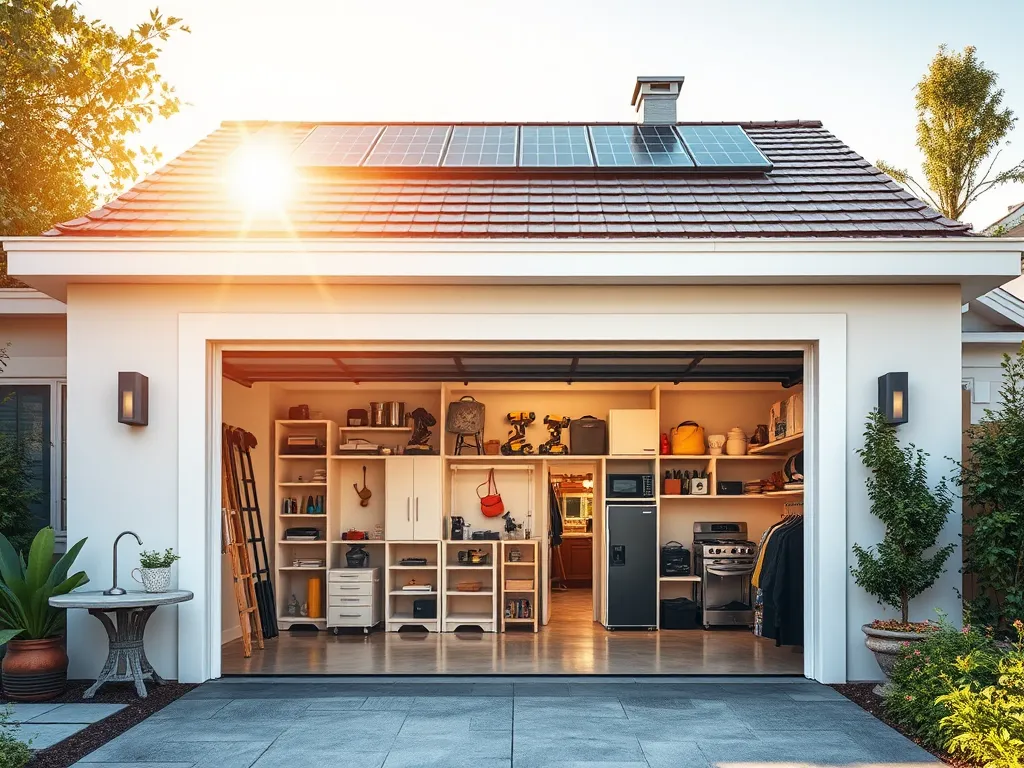Maximizing Energy Efficiency with Your Garage Door

Garage Door Energy Efficiency: Enhancing Climate Control and Saving Money
Garage door energy efficiency is an essential aspect of maintaining a comfortable and cost-effective home environment. By optimizing the energy efficiency of your garage door, you can significantly reduce heating and cooling costs, enhance the overall comfort of your living space, and decrease your carbon footprint. Understanding the key factors that influence garage door energy efficiency will help homeowners make informed decisions when it comes to their garage doors, whether that involves insulation, smart technology, or regular maintenance.
One of the most critical components of garage door energy efficiency is insulation. An insulated garage door can prevent unwanted heat loss during winter and keep your garage cooler in the summer, resulting in reduced reliance on heating and air conditioning systems. Additionally, insulated doors can create a more comfortable environment in adjacent living spaces by reducing outside noise and temperature fluctuations. Evaluating the insulation levels of your garage door can lead you toward improved energy savings.
Smart technology is transforming the way we manage our homes, and garage doors are no exception. By incorporating smart solutions into your garage door system, you can enhance its energy efficiency. Smart garage door openers can be programmed to open only when needed, minimizing unnecessary energy loss. Moreover, modern systems often include energy monitoring features that allow homeowners to track energy usage and identify potential savings. Combining smart technology with other energy-efficient practices can significantly boost the performance of your garage door.
Proper maintenance is vital for ensuring garage door energy efficiency. Regular upkeep can prevent energy loss due to wear and tear, including damaged insulation and worn weather sealing. Homeowners should prioritize routine inspections and maintenance tasks such as sealing leaks, lubricating moving parts, and checking the overall integrity of the garage door system. This preventive care can enhance the door's performance and prolong its lifespan, ultimately leading to long-term energy savings.
As homeowners explore energy-efficient options, selecting the right garage door model is critical. Different designs and materials can vary significantly in energy efficiency. While some doors come pre-insulated, others may require additional insulation to meet energy-saving goals. Understanding the features of energy-efficient garage doors and comparing them to standard models will help homeowners determine the best choice for their budget and needs. Investing in an energy-efficient garage door can result in substantial energy savings and a more comfortable living environment.
Understanding the r-value importance in insulation materials can lead to better energy savings.
Insulation Techniques for Garage Doors
There are various types of insulation materials available for garage doors, including polystyrene and polyurethane foam. Polystyrene is a rigid foam board that provides good insulation properties, but polyurethane foam has a higher insulation value, making it more effective in preventing heat loss. Additionally, reflectively insulated doors can also be used, where a layer of reflective material is included to reflect heat back into the garage, enhancing insulation performance.
Effective weatherstripping techniques are crucial for maintaining a comfortable indoor temperature year-round.
Insulated garage doors provide several benefits for energy efficiency. They can help maintain a stable temperature within the garage, preventing extreme heat or cold from affecting the rest of your home. This stability can also protect any climate-sensitive items stored in the garage, such as electronics or perishable goods. Furthermore, insulated doors can reduce outside noise, creating a quieter indoor environment while also saving on energy costs associated with heating and cooling systems.
Installing insulation in garage doors can be a straightforward DIY project for some homeowners. First, it is essential to measure the door's dimensions accurately and select the appropriate insulation material. Homeowners can either use insulation kits that come with pre-cut panels or cut insulation materials to fit the door's configuration. It's crucial to ensure a secure fit and seal all edges to prevent air leakage, which is vital for maximizing energy efficiency.
Learning about different garage door insulation types can significantly enhance your home's energy efficiency.
When comparing insulated versus non-insulated garage doors, the benefits of insulation become evident. Insulated doors have a higher R-value, which measures insulation effectiveness, leading to reduced heat transfer. In contrast, non-insulated doors can contribute to higher energy bills as they allow drafts and temperature fluctuations. Therefore, investing in an insulated garage door model can yield significant savings over time, particularly in climates with extreme temperatures.
The cost-saving potential of insulating garage doors can be substantial. While the initial investment might be higher for insulated models, the energy savings can offset this cost in the long run. Homeowners may notice lower utility bills, particularly during peak heating and cooling seasons. Furthermore, the increased comfort in the garage and adjacent living spaces can enhance the overall value of the home, making insulation a wise investment.
Smart Garage Door Solutions
Smart technology enhances garage door energy efficiency by allowing homeowners to monitor and control their garage doors remotely. This means users can verify whether the door is closed, open, or in need of adjustment directly from their smartphone, thus preventing energy loss through unattended open doors. Furthermore, smart garage door systems often include energy-efficient settings that optimize performance based on usage patterns.
Energy monitoring systems for garage doors can provide valuable insights into energy consumption. These systems track how often the garage door is opened and closed, allowing homeowners to analyze patterns and determine if changes in usage could lead to energy savings. By identifying opportunities for more efficient operation, homeowners can make informed decisions based on actual usage data.
Automating garage door openings is another effective way to save energy. Smart garage door openers can utilize scheduling features to control when the door opens and closes. By limiting unnecessary openings, homeowners can reduce energy loss and ensure that the garage maintains its temperature more effectively, contributing to lower heating and cooling costs.
Integrating smart home systems for efficiency is beneficial to overall energy management. Smart garages can connect with other home automation systems, enabling synchronized operation with HVAC systems, lights, and security devices. This interconnected approach ensures that energy is used strategically throughout the home, helping to maximize overall efficiency and comfort.
Smart sensors in garage doors can detect changes in temperature or humidity levels, allowing for responsive adjustments to maintain optimal conditions. For example, if the temperature in the garage rises significantly, the sensor can notify the homeowner. This insight enables timely actions to prevent excessive energy use and maintain energy efficiency in the garage area.
Maintenance Tips for Energy Efficiency
Regular maintenance is crucial for achieving optimal performance in garage doors. Homeowners should schedule periodic inspections to check for any signs of wear, damage, or inefficiencies. Maintenance tasks can include lubricating moving parts, tightening hardware, and checking for any loose or worn components that could affect energy efficiency.
Sealing leaks and drafts in garage doors is essential for minimizing energy loss. Homeowners should inspect the edges and corners of the door for gaps or damaged weather stripping. Using weatherstripping materials to seal these areas can prevent unwanted air from entering or exiting, leading to a more energy-efficient garage environment.
Lubrication practices enhance the efficiency of garage doors by ensuring smooth operation. Applying appropriate lubricants to moving parts, such as rollers and hinges, can reduce friction and promote seamless opening and closing of the door. This reduces the wear on the mechanical components and helps maintain energy efficiency over time.
Inspecting and replacing worn weather stripping is vital for maintaining energy efficiency. Over time, weather stripping can degrade, leading to leaks that allow heat to escape or cold air to enter. Regularly checking seasonal changes in the weather stripping condition and replacing it as needed can enhance insulation performance.
The importance of a professional garage door inspection cannot be overstated. While DIY maintenance is beneficial, a trained technician has the expertise to identify issues that may not be immediately noticeable to homeowners. Professional services can ensure that the garage door operates efficiently, leading to long-term energy savings and improved overall performance.
Selecting Energy-Efficient Garage Door Models
When selecting energy-efficient garage door models, homeowners should look for features such as high insulation ratings (R-value), durable weather stripping, and energy-efficient materials. Steel or fiberglass doors with insulated cores often provide the best energy performance, while lightweight materials with reflective properties can help maximize thermal efficiency.
Energy Star rated garage doors come with many benefits, including assurance of high energy efficiency standards. These doors have been tested for insulation effectiveness and are designed to minimize energy loss, making them a smart investment for homeowners looking to enhance energy performance. The Energy Star label also signifies a commitment to sustainability, which can be appealing to environmentally conscious homeowners.
Cost comparison between energy-efficient and standard doors often reveals significant long-term savings. While energy-efficient models may have a higher upfront cost, they frequently reduce energy bills more dramatically over time, offsetting any initial investment. Homeowners should consider the entire lifecycle cost of their garage door when evaluating options, looking for potential savings over years of usage.
Design plays a vital role in energy efficiency when it comes to garage doors. Choices between single-layer or multi-layer designs can affect insulation performance, with multi-layer designs typically providing better energy efficiency. Additionally, the choice of color and finish can impact heat absorption, influencing the overall energy performance of the door.
The role of materials in garage door energy performance cannot be overlooked. Materials such as solid wood or thick steel can offer superior insulation properties compared to lower-quality materials. Homeowners should evaluate not only the aesthetic appeal of the materials but also their thermal performance to achieve the best energy efficiency outcomes.
The Impact of Garage Doors on Home Energy Costs
Understanding energy loss through garage doors is essential for homeowners seeking to improve energy efficiency. Garage doors are significant areas of energy loss, particularly in homes with attached garages. An uninsulated garage door can lead to drafts and significant temperature changes that impact overall home energy costs.
Calculating potential savings with efficient doors can provide valuable insight for homeowners. By estimating energy loss due to inefficient garage doors, owners can gauge the benefits of upgrading to insulated or energy-efficient models. This analysis can also help in determining payback periods for investments in new doors or insulation upgrades.
The role of the garage in home energy management is increasingly recognized. A well-insulated garage can help stabilize home temperatures by acting as a buffer between the interior living areas and the outside environment. This stability can lead to lower energy consumption for heating and cooling, ultimately enhancing overall energy management.
Climate impact is another factor to consider when assessing how garage doors affect heating and cooling. In regions with extreme weather conditions, garage doors can either exacerbate energy loss or enhance energy performance based on their design and insulation properties. Homeowners in such climates should prioritize investing in high-quality, insulated doors to mitigate these impacts.
Evaluating the energy efficiency of older garage doors is a crucial step for homeowners looking to reduce energy costs. Many older models lack adequate insulation and sealing features, leading to enhanced energy loss. Replacing these doors with modern, energy-efficient options can provide substantial energy savings and improve overall comfort in the home.
